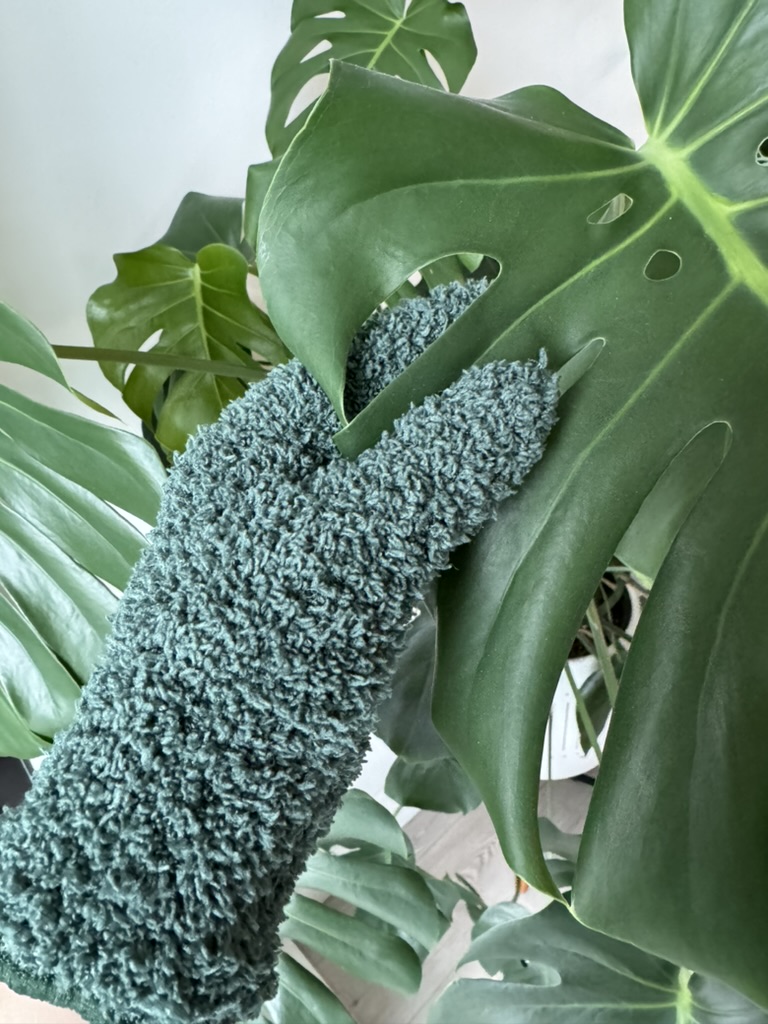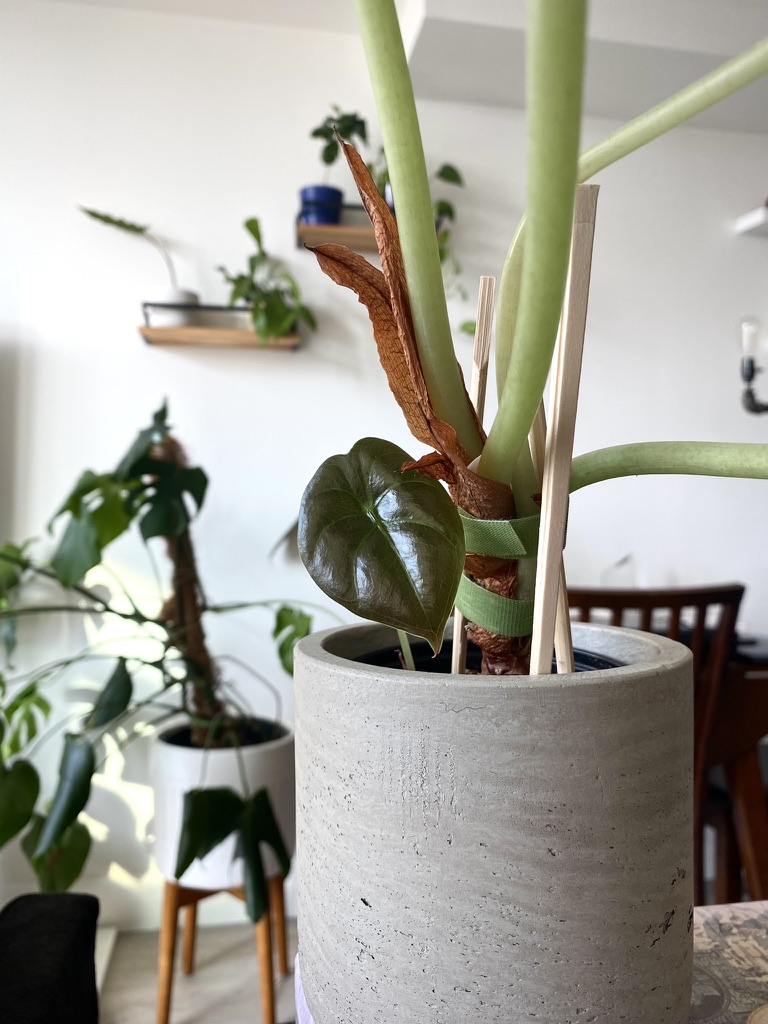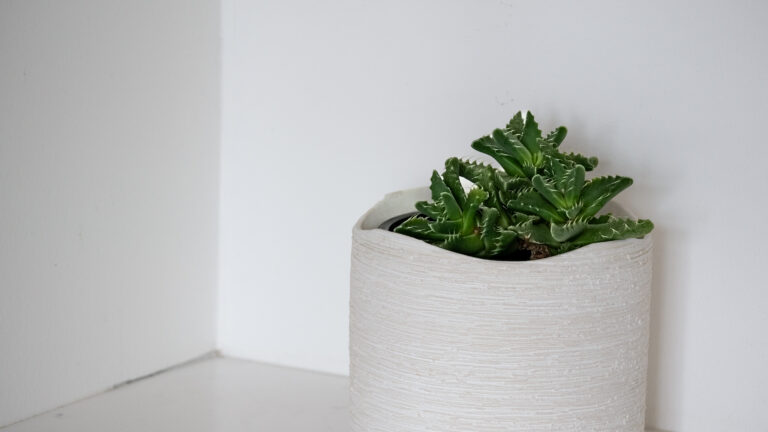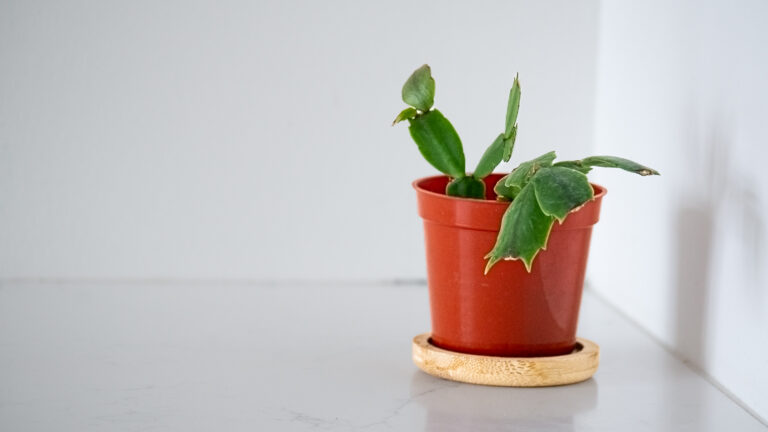False Shamrock or Oxalis Triangularis is a member of the Oxalidaceae family. It is native to Peru, Brazil and Northern Argentina.
Oxalis Triangularis is referred to as the False Shamrock because its leaves resemble a shamrock.
The Oxalis Triangularis has a circadian rhythm. At night the leaves fold down as the sun goes down. As the sun comes up, the leaves open.
There are around 570 species of the Oxalidaceae family.
🪴 Appearance of False Shamrock
The Oxalis Triangularis has three triangular purple leaves that connect to a long, thin purple petiole.
During the day, the leaves are open to the sun. At night, the leaves close up.
☀️ What Light Does False Shamrock Need?
False Shamrock thrives in bright, indirect light. They prefer a few hours of sun in the morning or afternoon when the light is less harsh, and indirect light for the remainder of the day.
I keep my Oxalis Triangularis in the middle of the room with a bright window that lets in southwest facing sun.
🌡️ What Temperature and Humidity do False Shamrock Like?🌫️
False Shamrock actually prefers cooler temperatures (15 degrees celsius), but will tolerate warmer indoor temperatures as long as they don’t exceed 27 degrees.
They also prefer average humidity of 40-60%. I set my Levoit Hybrid Ultrasonic Humidifier (LV600HH) to 50% to keep all of my plants happy.
Since I live in Canada and the winters can be very dry, and the humidity can drop below 30% humidity, so its helpful to set the humidity at about 45% or 50% in this season to keep all of my plants happy.
🌱 How Does the Oxalis Triangularis Grow?
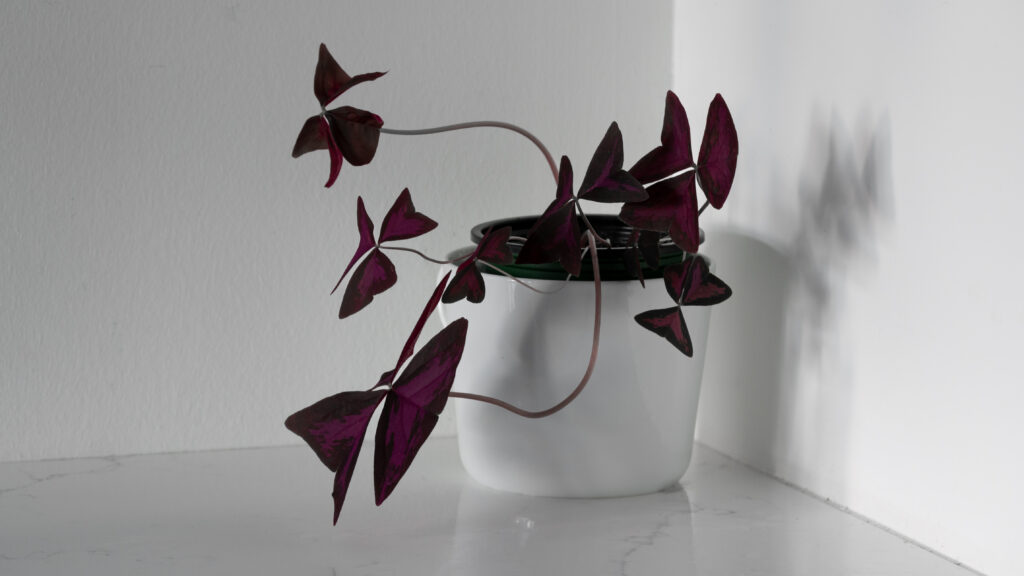
On average, False Shamrock can grow up to 1.5 feet.
New foliage grows out of a tuber from the soil. A petiole will emerge with three small folded leaves. As the plant grows, the leaves open and grow larger.
Oxalis Triangularis will also grow tiny, pale purple flowers out of the rhizome when it blooms.
🌸 Does the False Shamrock Bloom?
Oxalis Triangularis does bloom. Its flowering period is from spring to autumn.
✂️ How to Propagate False Shamrock?
The easiest way to start a new Oxalis Triangularis is by corms.
Sometimes new plants may emerge from the soil (grown from a corm), but most of the time you will find the corms near the roots of the plant. You will likely have to dig around the soil to find a corm.
You can remove the corm from the soil and place it in a new planter filled with soil. Bury it below the soil about 1 to 2 inches and water this like you typically would (about once a week, when the soil is half dry).
Eventually a petiole will emerge from the soil and you will know you successfully propagated your False Shamrock. It’s best to go through this process at the end of the dormancy period.
💧 How Much Water Does the False Shamrock Need?
The False Shamrock likes to be watered when half dry (about once a week). To determine if your plant needs water, you can stick your finger in the soil (1 to 2 inches) and if it is dry, its ready for water!
If you don’t want to get your hands dirty, you can try a moisture meter.
I typically bottom water this plant through the drainage hole of the pot on a tray. It’s the easiest way to know if your plant is thirsty or not. Overwatering can lead to a variety of issues such as fungus gnats, root rot, or the death of your plant.
You can top water, but it’s best to do so in a pot with drainage until water is flowing out of the hole. If your pot doesn’t have drainage, you might accidentally overwater your plant.
You should top water from time to time to make sure any built up minerals can wash through the plant. The water should drip out of the bottom of your drainage hole.
🪴 Repotting Oxalis Triangularis
- Remove false shamrock from pot
- Detangle roots
- Add well draining soil to pot
- Add False Shamrock to the pot of soil and make sure you bury the bulbous part below the soil (but don’t press too hard as you can end up breaking the stems off of it. See video below).
- Make sure the plant is secure and water the plant.
🪳 Pests & Problems 😔
False Shamrock can face the following pests and problems. However, in my 4 years of owning this plant, I have not had any pests.
🪳 Pests
- Mealy Bugs: these look like little white cotton balls on the False Shamrock. You can remove these with your fingers if you catch them early enough, but I would use a cotton swab with a drop of Isopropyl alcohol and try to scrape them off the stem (mainly cause I think they are kind of gross).
- Scale: Scale are small, brownish, round or oval insects that attach themselves to the leaves or stems of the False Shamrock. They are hard to notice as they appear like a growth or bump on the plant, and there may be a sticky substance. Removing scale from a plant is tedious, like with mealybugs. You can remove scale by manually removing them with a cotton swab with isopropyl alcohol, using insecticidal soap or neem oil.
- Spider Mites: You will know you have spider mites if you see webbing and leaf damage. If spider mites have taken to your Oxalis Triangularis, spray them with a mixture of neem oil, dish soap and water (or you can buy an insecticidal soap). I repeat this about once or twice a week (depending on the severity of infestation) for about a month. It’s also good to do this preventatively once a month or so. Learn how to eradicate Spider Mites.
- Fungus gnats: Spray the plant with a mixture of neem oil, dish soap and water. I also let the soil dry out and add dryer sheets on top of the soil so the gnats can’t sense the moisture on the soil.
😔 Other Common Problems
- Overwatering: Root rot happens from overwatering your False Shamrock with insufficient drainage. You can improve the drainage of your plant by ensuring your plant is potted in a planter with a drainage hole and using a well draining soil (something with a decent amount of perlite). You can also end up with fungus gnats or fungal disease from overwatering.
- Underwatering: Even though plants prefer to be underwatered over overwatered, you still have to remember to water it on a consistent schedule. Signs of underwatering can include leaves looking dry around the edges.
- Fungal Disease: Leaf spot or anthracnose are types of fungal diseases that impact False Shamrock. They will appear as brown or black spots. Its best to remove the affected leaves and potentially any they are touching to stop the disease from spreading.
☢️ Are False Shamrock Toxic?
False Shamrock is moderately toxic to humans and pets if ingested.
False Shamrock Quick Care Guide
| Scientific Name | Oxalis Triangularis |
| Nickname | False Shamrock |
| Origins | Peru, Brazil and Northern Argentina |
| Light | Bright, indirect light (some morning sun or afternoon sun) |
| Temperature | 15-27 degrees celsius |
| Humidity | Average humidity (40-60%) |
| Height | Up to 1.5 feet |
| Blooms | Yes |
| Propagate | Tubers (corms) from the soil |
| Water Frequency | When half-dry (like once a week or every other week) |
| Pests | Mealy Bugs, Scale, Spider Mites, Fungus Gnats |
| Common Problems | Overwatering (root rot), underwatering (crispy edges), fungal disease (brown or black spots) |
| Toxicity | Moderate (not safe when ingested) |
References
Below is a list of external sources I consulted while writing this post. This post is a mixture of my own experiences, and the external sources listed below:
Jomo Studio – Oxalis
Royal Horticultural Society – Oxalis Triangularis
Wikipedia – Oxalis Triangularis
Houseplant 411 – Oxalis Triangularis Common Pests and Problems

